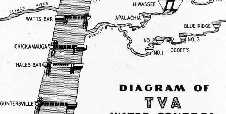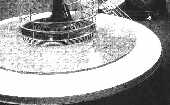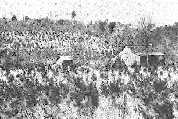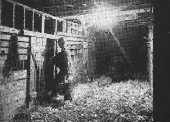Ischia, 1955
The South in the U.S.A.
by Howard K. Menhinick, Regents’ Professor of City Planning, Georgia Institute of Technology, Atlanta, GeorgiaThe South in the U.S.A. with which we are concerned in this paper consists of the states of Maryland, Virginia, North and South Carolina, Florida, Georgia, Alabama, Mississippi, Louisiana, Tennessee and Kentucky. This is a region of great diversity in climate, soils, rainfall, resources, and people.
The South at the Turn of the Century
At the turn of the century this region was predominantly agricultural. Cotton, corn, tobacco, lumber, and naval stores were its principal crops with cotton predominating. In the mountainous portions of the region, isolated, independent farmers eked out a bare living on small tracts of land. In the more southern and level piedmont and coastal plain portions of the region, there still remained many of the large pre-Civil War plantations devoted largely to cotton and operated by tenants and sharecroppers who for the most part were Negroes. The plantation owners lived a life of ease and luxury and it is around them and their way of life that much of the romance of Southern graciousness and hospitality has been built. By contrast, the life of the sharecropper was a meager one. On the harvesting of each cotton crop, the sharecropper, if fortunate, was able to pay the debts he had accumulated during the year and be ready to start into debt again.
Catastrophe struck the South with the appearance of the destructive cotton pest - the boll weevil. This insect forced the South to abandon its one-crop cotton economy and seek economic diversification. Textile mills were encouraged to move from New England to the South to take advantage of low-wage Southern labor and to escape labor unions. They built mill villages for the housing of their employees and developed an almost feudal system of living. Practically all of the southern industries of this period were financed almost entirely by northern capital. Their earnings were siphoned out of the South and sent to their northern stockholders. For the most part, these industries did only primary processing. Raw materials - cotton, lumber, ceramic clay, and so on - and semi-processed materials were sent to the North for the final processing stages (in which the greatest value is added). Many of the finished goods were reshipped to the South for consumption. This system was strengthened by a rail-rate structure which provided low freight rates for raw materials and semi-processed materials going North with high rates for finished products going North and low rates for finished products coming South. The South, at this period, was essentially a colony of the North.
The low industrial wages of the South, the predominance of agriculture, and the high proportion of poorly educated, low-productive Negroes kept the average per capita income in the South the lowest in the nation. The widespread incidence of the debilitating diseases of malaria and hookworm further lowered the workers’ productivity.
One aspect of this situation in the South in this era was well characterized in the now famous words of an Atlanta newspaper editor, Henry Grady.
“I attended a funeral once in Pickens County in my state Georgia. A funeral is not usually a cheerful object to me unless I can select the subject. I think I could perhaps without going a hundred miles from here find the material for one or two cheerful funerals. Still this funeral was peculiarly sad. It was a poor “one-gallus” fellow whose britches struck him under the arm pits and hit him at the other end about the knee They buried him in the midst of a marble quarry; they cut through solid marble to make his grave and yet a little tomb stone they put above him was from Vermont. They buried him in the heart of a pine forest and yet the pine coffin was imported from Cincinnati. They buried him within touch of a iron mine and yet the nails within his coffin and the iron in the shovel with which they dug his grave were imported from Pittsburgh. They buried him by the side of the best sheep grazing country on the earth and yet the wool in the coffin bands and the coffin bands themselves were brought from the North. The South did not furnish a thing on earth for that funeral but the corpse and the hole in the ground. There they put him away and the clods rattled down on his coffin and they buried him in a New York coat and a Boston pair of shoes and a pair of britches from Chicago and a shirt from Cincinnati leaving him nothing to carry into the next world with him to remind him of the country in which he lived and for which he fought for four years but the chilled blood in his veins and the marrow in his bones.” (1)
These conditions prevailed in the South into the depression of the 1930’s. At that time the South was aptly characterized as the nation’s “Economic Problem No. l.”
Within 20 years from 1930 to 1950, the South has changed from America’s Economic Problem No. 1 to America’s new frontier and land of opportunity - a region of steadily increasing prosperity.The New South as Exemplified by the Tennessee Valley
I should like to tell you of these changes and how some of them came about, in terms of the portion of the South with which I am most familiar, the Tennessee Valley. I hope that the experiences in the Tennessee Valley may contain some ideas that will have application to the problems of Southem Italy and that we, in turn, may take back to the United States new ideas growing out of your experiences.The Tennessee Valley in 1933
The Tennessee Valley, the watershed of the Tennessee River and its tributaries, lies as a great half moon in parts of the seven states of Virginia, North Carolina, Georgia, Alabama, Mississippi, Tennessee, and Kentucky. It contains 40,000 square miles of varied topography - mountainous in the northeast, a high and relatively flat plateau in the middle northern section, and low, flat lands in the southern portion. The region is bisected from Virginia to northern Alabama by a great valley in which most of the cities, the industries, and the people of the region live. The Tennessee Valley has an average rainfall of about 40 inches reasonably well distributed throughout the year. It has an equable year-round climate. A large portion of the Valley consists of cut-over forests.
In 1933, much of the soil of the Tennessee Valley was seriously eroded and its forests were largely neglected or destroyed. The living standards of its 3,000,000 people and their average per capita income were the lowest in the nation - about $ 150 or approximately 40 per cent of the national average at that time. Outmigration from the region in search of economic opportunity was high, malaria was prevalent, diets were inadequate, and the people were discouraged. The Tennessee River was more of a liability than an asset. Spring Hoods washed away topsoil and brought destruction to the Valley and its people. In summer and early fall the river receded to a mere trickle with shallow pools in which malaria mosquitoes flourished. The river of this period was once characterized as “too thick to swim in, too thin to plow.”
These conditions existed despite the varied and abundant resources of the Valley, including people of fine basic character and intelligence, a favorable growing season, potentially productive soils and forests, coal and other minerals, scenic resources, and an abundance of water. But the key to the release and productive utilization of these resources was lacking.Establishment of the Tennessee Valley Authority
The Federal government, through the Tennessee Valley Authority, provided the missing key. This agency was created in 1933 to stimulate the development of all of the resources of the Tennessee Valley in an integrated manner. Through the building of a unified system of great dams, the river was to be harnessed and put to work for navigation flood control, and hydroelectric power development. New types of agricultural fertilizers were to be developed and demonstrated. The work of controlling the river was recognized as a primary responsibility of TVA.Navigation
Twenty dams and reservoirs have been built by TVA to make the Tennessee River system one of the most completely controlled streams in the world. The main river, from its point of origin just above Knoxville, to its junction with the Ohio River near Paducah, Kentucky, consists of a 630 mile long connected chain of lakes over which commercial navigation moves in rapidly increasing amounts. The Tennessee River is linked with a 9000 mile inland waterway system serving 20 of the 48 states. In 1954 the Tennessee River carried more than a billion ton-miles of traffic with savings in freight costs of more than $ 12 million. Cargoes included grain from the Midwest, automobiles from the Great Lakes states, petroleum products from the Southwest and Midwest, steel from Pittsburgh and Chicago, fertilizer to the Midwest, coal from Ohio River ports, and salt and sulfur from the Gulf coast.Flood Control
The controlled river system has averted more than $ 58 million of flood damage that would otherwise have occurred during the last two decades. In January, 1954, the control system lowered by 12 feet what would otherwise have been the crest of a flood at Chattanooga, Tennessee, averting on that one occasion $ 7,600,000 in damage at that city alone.Hydroelectric Power
In July 1954, TVA had installed in its dams 2,300,000 kilowatts of hydroelectric capacity and 757,500 kilowatts of steam generating capacity. About 30 billion kilowatt-hours of electric energy were sold by TVA during the 1954 fiscal year. However, there are other figures on the use of electric energy that have more significance in terms of regional development.
TVA electric power is distributed retail throughout the Valley by Municipal Power Boards and Rural Electric Cooperatives.
In 1954, the average cost per kilowatt hour of electricity to consumers was 1.26 cents in the TVA region, compared with 2.72 cents in the Nation. The number of residential consumers was 1,117,000 which was five times the number in the region in 1933. At the end of 1954, 436,000 farms had electric service. Only 15,000 had such service in 1933.
The development of the river system for navigation, flood control, and hydroelectric power was planned and carried out as a direct operation by TVA.Fertilizer Production and Demonstration
At Muscle Shoals, Alabama, there were World War I munitions plants which were turned over by the federal government to TVA to keep in stand-by condition and to use for the production and demonstration of new types of mineral fertilizers. High concentrate phosphatic fertilizers and other types developed in these plants have been tested by the farmers of the region under actual farming conditions. These programs have greatly encouraged the development of pastures and livestock in the Valley, diversifying the agriculture, adding substantially to the income of farm families, and improving their diets.Not a Planned Region But a Planning Region
The planning and accomplishment of the development of the other resources of the entire valley required the participation of countless individuals and many different governmental agencies. TVA early recognized that no one agency could prepare a master plan for the development of the Tennessee Valley that would have general acceptance or real significance. It was recognized that “the planning of the Valley’s future must be the democratic labor of many agencies and individuals, and final success is as much a matter of general initiative as of general consent.” (2) Accordingly, there has never been attempted a Master Plan blueprint for the development of the Tennessee Valley. Another reason for not preparing a Master Plan for the Valley was the early adoption of a concept set forth by John Dewey. The objective of Valley development became not a planned region but a planning region.Resource Interrelationships and Democratic Participation
TVA further recognized that all of the resources of a region are interrelated and that maximum accomplishments can be obtained only as all of the resources are planned together. When such planning is done with imagination and enterprise, many unanticipated gains are obtained. In some cases the by-products have proved more valuable than the initial objective.
Regions have many different problems and many different resources and opportunities. Some have neither the need nor the financial resources to construct a great system of dams and reservoirs. This aspect of the TVA program may therefore have little applicability for them. There are, however, two aspects of the TVA program and the lessons growing out of it that have a carry-over value wherever men work together to better their standard of living through the wise and effective utilization of their resources. These two aspects are: l) the interrelated nature of resources and the great gains that may be achieved when plans take account of these interrelationships; and 2) the gains that may be realized when responsibility and initiative are decentralized and when all of the people of the region are enlisted as participants in a resource development program rather than mere recipients upon whom a program is imposed. I propose to devote the remainder of the paper to a few specific illustrations from the Tennessee Valley of these two aspects of resource development.Diking and Dewatering Projects
At first glance, malaria-bearing mosquitoes, small grains, and wild ducks and geese may appear to have only a slight relationship, hut Nature and men sometimes tie objects together in surprising combinations.
In the Kentucky reservoir of the Tennessee River there were low-lying, fertile river bottom lands which would he shallowly flooded by the waters impounded behind Kentucky Dam. Flooding would remove these lands from useful agricultural production and provide almost ideal breeding places for the malaria-bearing mosquito, thus adding substantially to the costs of malaria control.
In lieu of permitting this flooding, TVA built dikes around these lands and pumping stations to remove the rainfall and surface drainage behind the dikes. At the end of each winter, the water is pumped from these areas and the fertile lands are rented to near-by farmers for the production of small grains. Thus, during the malaria-mosquito breeding season the land is dry and no malaria mosquitoes are produced. Rent consists of a portion of the crop which is left unharvested. After the farmer has harvested his share of the crop in the fall, the gates in the dikes are opened and the area is flooded with the waters of Kentucky reservoir. These areas have been previously designated as protected wildlife refuges. Ducks and geese, migrating from the North, stop by tens of thousands to rest and to feed on the flooded, unharvested grain. The remaining portions of the reservoir, in which ducks and geese are not protected, have become a duck-hunters’ paradise. Hunters come from far and near, bringing with them a need for hunting equipment and ammunition, boats, guides, meals and lodging which the local residents furnish. Thus, in addition to the profit obtained from the farming of these rich bottom lands the near-by residents have another source of income from materials and services to hunters. The cost to TVA of the diking and dewatering project was less than the cost of a continuing program of a malaria control by conventional methods.The Story of Decatur, Alabama
The changes that have taken place since 1933 in the city of Decatur, Alabama, is a story both of integrated resource development and of widespread participation in program determination and development.
In 1933, the citizens of Decatur were financially bankrupt, sick, and discouraged. Malaria was rife in the city, which had only recently recovered from a disastrous yellow fever epidemic. The one source of income of its people, a railroad car shop, had just terminated its operations permanently.
As one of the first steps, TVA eliminated the malaria hearing mosquitoes that were breeding along the river, initially by dusting, supplemented later by rapid weekly fluctuations of the reservoir, and by the construction of diking and dewatering projects. Malaria has now disappeared from Decatur.
After the nine-foot navigation channel was completed to Decatur, a Nebraska flour mill built a plant there, shipped in its grain by barge, and ground it into flour. The flour mill provided local employment. It also furnished an assured market at a fair price for all the grain that could be produced locally. Fields were taken out of corn and tobacco and devoted to the growing of grain.
The availability of grain made possible the production of dairy and beef cattle which, in turn, provided a new source of income and improved diets. The cattle required pasture, so more lands were removed from cotton and tobacco and devoted to these purposes. The cattle necessitated the construction and operation of a creamery and cattle auction pavilion. The availability of grain made possible the raising of broiler chickens. For the chicken feed, alfalfa was required so more land was withdrawn from cotton and tobacco and an alfalfa dehydrating plant was built. An existing basketmaking plant that was about to discontinue operations found a new source of income in making crates in which to ship the broilers. The availability of the nine-foot navigation channel led to the establishment of a ship-building yard on what had formerly been a cotton field.
With all these encouraging changes taking place, the city of Decatur began to take a new interest in its development. On the urging of TVA, it established a city planning commission which prepared plans for the integrated development of the city with new schools, parks, highways, a hospital, industrial and recreational waterfront, and so on. Additional money was required to finance these improvements So the planning commission, at the request of the City Council, made a careful study of present sources of revenue and how their yield might be increased, of how present income might be expended more efficiently, and then suggested possible new sources of revenue.
Substantially all of the recommendations of the report have been carried out. At about this time, the Wolverine Tube Company was seeking a new location for a plant and narrowed its choice to Decatur and a Mississippi city. It finally selected Decatur and gave as the reasons for its decision, among others, the fact that Decatur was planning and developing a city with good community services and facilities. Decatur was rapidly becoming a city in which their employees would be happy to live and this, in turn, would help assure a low labor turnover. Furthermore, they stated that although the financial condition of Decatur was not much superior to that of the Mississippi city, Decatur had a definite program for improving its financial situation and the other city did not. Thus, good city planning and development resulted in a new industry for Decatur. Other industries have come to the City also. Decatur, formerly bankrupt and discouraged, now boasts that it is the heart of a new inland empire. The developments that led these changes did not occur automatically or accidentally. They came about because of a growing understanding of resource relationships and a willingness and desire on the part of many community leaders and citizens to accept responsibility and exercise initiative in taking advantage of new opportunities.A New County Library Board is Created
At its construction village at Fontana Dam, a public library was needed to serve TVA’s construction workers. Instead of providing this library, itself, as it might easily have done, TVA encouraged Swain County to create a County Library Board.
TVA provided quarters for the library at its construction village, purchased the required books, paid the salary of a librarian, and encouraged the County Library Board to make books available to any resident of the County. Many TVA construction workers resided throughout the county, so this was a justifiable provision. The result of this method of providing the required TVA library services was that all of the people of the county gained the advantages of these services and the cost to TVA was no greater than would have been the cost of providing the library, itself. The big pay-off came when the construction of Fontana Dam was completed. The library which would otherwise have been abolished at the termination of the project, was continued by the County Library Board. Thus the benefits go on long after TVA financial and other participation has ended.Farmers Assume the Lead in Testing TVA Fertilizers
At its plant at Muscle Shoals, Alabama, TVA developed new types of agricultural fertilizers - notably high concentrated phosphatic fertilizers - through the use of an electric kiln. These fertilizers were tested by TVA, first in a greenhouse, then in outdoor field plots, and finally in fields. They appeared to be successful.
The next required test was their utilization by farmers under typical farming conditions. The state agricultural colleges and their county agents undertook to secure this testing by farmers on a voluntary basis.
In each agricultural community, the farmers were asked to select one of their neighbors who was willing to test the new fertilizers by continuing, over a period of several years, a farm program to he developed jointly by the farmer and the County agent. During the testing period the farmer agreed further to keep accurate records of his farm operations and to permit his neighbors to observe his farm operations and to inspect his records. The TVA furnished the required fertilizer free, in the initial stages, and at a nominal price in the later stages. The farmer purchased lime, seeds, and other materials required. He was known as a test demonstration farmer. In a few cases, entire farming communities served as test demonstrators.
As the farmer’s neighbors watched his worn-out fields grow green with grass and other cover crops, erosion cease, sheep and cattle multiply and flourish, farm buildings improve as his income increased, and electricity take over many of the farm chores, they too, began to use the new fertilizers and adopt the new farm practices.
Today, as one travels through the Tennessee Valley, the results of the program can be observed in fields that are green with winter cover crops, in neatly painted farm houses and in many other evidences of the improved utilization of soil resources. There is a long road yet to be traveled but the farmers of the Valley are on their way in a program that they, themselves, have developed.The Valley and the South Today
There are many other examples in the Valley of the gains that have been achieved by recognizing and taking advantage of the unified nature of resources. The developments that have taken place in the Valley could never have been attained by TVA alone. They were made possible by the teamwork of TVA, state and local governments, numerous citizens’ organizations, and countless citizens. The farms and the urban communities of the Valley , through the joint efforts of these groups, have become better places in which to live and work and play. Per capita income has increased from about 40 per cent of the national average to about 60 per cent and most observers believe that it will continue to climb.
Similar progress is being made throughout the South. The increased purchasing power of the people of the South is attracting new industries that wish to be near the expanding Southern market. Southern industries are manufacturing more and more of the products Southern people use. Discriminatory freight rates are being adjusted. Henry Grady would be well pleased by the changes that can be observed today. Textile mill villages are being sold to their occupants. Wage differentials are gradually disappearing. Perhaps best of all, Southern boys and girls non longer have to go north or east or west in search of economic opportunity. They can find it at home.















